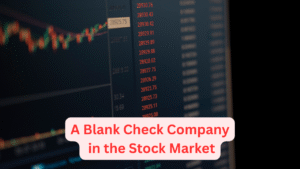 A Blank Check Company: What It Means in the Stock Market
A Blank Check Company: What It Means in the Stock Market
In recent years, one term has gained increasing attention in the financial world—Blank Check Company. These unique investment vehicles, also known as Special Purpose Acquisition Companies (SPACs), have become a popular way for private companies to go public without going through the traditional Initial Public Offering (IPO) process. But what exactly is a blank check company, and how does it work in the stock market? This article provides a clear and comprehensive understanding of this financial concept.
What Is a Blank Check Company?
A Blank Check Company is a publicly traded corporation formed strictly to raise capital through an IPO for the purpose of acquiring or merging with an existing private company. The name “blank check” refers to the fact that investors are essentially giving their money to a company without knowing what it will eventually invest in. These companies typically have no commercial operations at the time of the IPO. Their only asset is usually the money raised from the public offering.
The most common and widely recognized form of blank check company today is the SPAC. These entities have gained prominence for offering a faster, less cumbersome alternative to the traditional IPO route.
How Does It Work?
The process begins when a group of investors or sponsors with industry experience creates a SPAC and files with the Securities and Exchange Commission (SEC) to go public. The SPAC raises funds from institutional and retail investors through an IPO, typically pricing units at $10 each.
After the IPO, the raised capital is placed in a trust account. The SPAC then has a limited time frame—usually 18 to 24 months—to identify and merge with a private company. If the SPAC fails to complete a deal within the timeframe, it must return the money to investors.
Once a suitable private company is found, the SPAC negotiates a merger or acquisition. If the deal is approved by shareholders, the private company effectively becomes public through the transaction, bypassing the traditional IPO process.
Key Players in a SPAC
- Sponsors: These are the individuals or firms that create the blank check company. They usually have a background in finance or a specific industry and play a crucial role in identifying the target company.
- Investors: Investors buy into the SPAC’s IPO, hoping the sponsors will select a successful private company that increases in value once public.
- Target Companies: These are the private firms that agree to merge with the SPAC in order to become publicly traded.
Advantages of a Blank Check Company
- Speed and Efficiency: Going public through a SPAC can take just a few months, compared to the year or more that a traditional IPO might require.
- Certainty of Capital: The target company knows exactly how much funding it will receive once the merger is approved.
- Experienced Sponsors: Investors benefit from the knowledge and networks of seasoned sponsors.
- Less Regulatory Hurdle: While still regulated, SPACs face fewer disclosure requirements early on compared to traditional IPOs.
Risks and Criticisms
While SPACs and blank check companies offer opportunities, they also come with notable risks:
- Lack of Transparency: Investors have no idea which company the SPAC will acquire at the time of investment.
- Sponsor Incentives: Sponsors usually receive a significant stake—often 20%—at a nominal price, potentially misaligning interests between them and regular investors.
- Poor Performance: Historically, many SPACs underperform post-merger compared to traditional IPO companies.
- Regulatory Scrutiny: Due to their rapid growth and potential for abuse, SPACs have attracted increased attention from regulators like the SEC.
The SPAC Boom and Its Slowdown
From 2020 to early 2021, SPACs exploded in popularity, with hundreds of blank check companies raising billions in capital. High-profile deals, such as those involving electric vehicle startups and space travel firms, captured headlines. However, as of late 2021 and into 2022 and beyond, the SPAC market began to cool. Several deals underperformed or fell through, leading to a decline in investor enthusiasm.
Additionally, regulatory bodies began tightening rules around SPACs, requiring clearer disclosures and potentially treating post-merger entities more like traditional IPOs. These changes have made the process more rigorous and have slowed the pace of new SPAC launches.
Conclusion
A Blank Check Company, particularly in the form of a SPAC, represents an innovative yet controversial tool in the modern financial marketplace. For private companies, it offers a faster and more flexible route to public trading. For investors, it presents the possibility of substantial returns—but also significant risks. As with any investment vehicle, due diligence, understanding the structure, and recognizing the potential for both upside and downside are essential.
Whether SPACs remain a long-term fixture of the stock market or fade into niche status will depend largely on how they evolve to address investor concerns and regulatory expectations in the years ahead.
